Looking for ways to keep your sketchbook exciting? Try drawing a favorite historical building, your go-to snack, or an unexpected object trapped in a jar—it’s way more fun than it sounds! Mix in abstract patterns with wild colors, or fill a page with watercolor doodles that look like a burst of candy. Challenge yourself with emotions, mashups of animals, or song lyrics turned into art. There’s a whole world of creative prompts just waiting to spark your next masterpiece.
Key Takeaways
- Draw architectural landmarks or meaningful buildings, focusing on unique details and surrounding context for engaging sketches.
- Illustrate your favorite food, capturing its vibrant colors, textures, and appetizing presentation.
- Create abstract patterns or emotional expressions using your preferred color palette and creative mark-making techniques.
- Capture moments from your daily routine or nature walks, emphasizing ordinary scenes or interesting textures you observe.
- Visualize personal growth, cultural traditions, or imaginative concepts like dream skateboard graphics for creative sketchbook storytelling.
Draw a Beloved Historical Building
Buildings can be more than just bricks and walls—they’re keepers of memories and stories, almost like old friends quietly standing in place.
When artists decide to draw a historical building, they don’t just make a sketch of a structure—they tap into their own memories and the history behind those walls.
Pick a building that means something to you, like your childhood school or a quirky landmark from your hometown. Research the building’s style and history, noticing every cool detail—maybe it’s a wonky window, a fancy old door, or that weird gargoyle perched on the roof.
Add the garden, street, or even the neighbor’s barking dog for fun context. Try different drawing tools, like ink or watercolor, until your sketch feels alive and real!
Illustrate Your Favorite Food
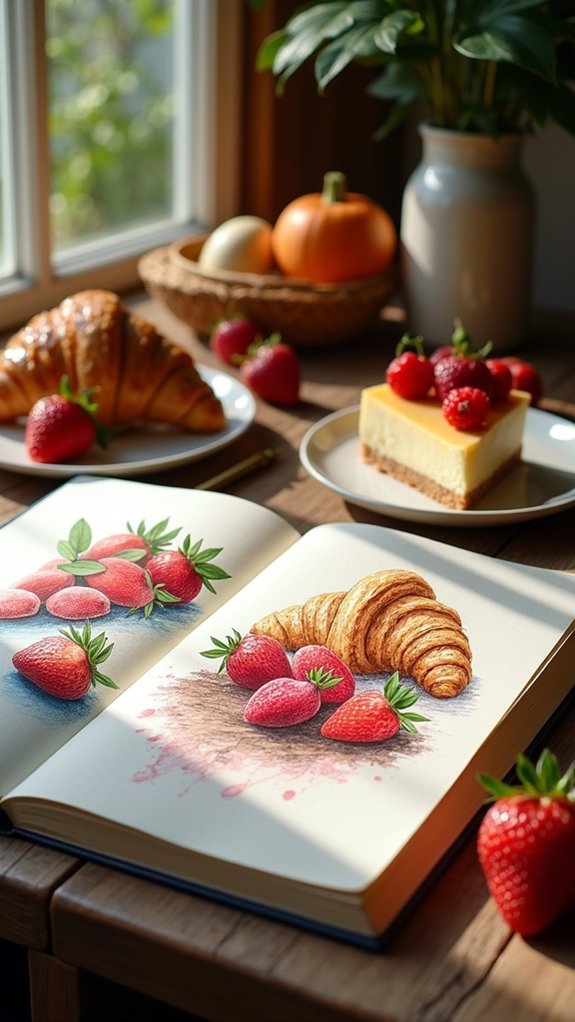
Illustrating your favorite food is a seriously fun challenge because you get to show off all the wild colors, shiny sauces, and weird bumps or crinkles that make it totally unique.
The presentation matters too, since a sprinkle of herbs or swirl of syrup can make even a simple snack look like it belongs on a fancy chef’s menu.
Capturing all those colors and textures isn’t just about making your drawing look tasty—it actually helps you see food in a whole new way!
Exploring Food Presentation
When someone thinks about their favorite food, it’s usually all about taste—cheesy pizza, gooey brownies, or maybe that spicy ramen bowl your best friend dares you to finish.
But what if you used color pencils to bring that dish to life as a drawing prompt in your sketchbook? Exploring food presentation challenges artists to notice the little details—maybe a sprig of mint on ice cream, or the way a vase of flowers sits near a homemade sandwich on the table.
Observing how foods are arranged helps artists capture the excitement of a meal. Is the burger leaning a bit? Did fries spill out of the paper wrapper?
With every detail, a pencil, and some imagination, that meal becomes a feast on paper.
Capturing Colors and Textures
After checking out how food is arranged, it’s time to zoom in closer—like, way closer.
Imagine picking just one food you love, and then drawing what makes it pop: the crunchy toast speckles, the gooey cheese drips, or those wild, bursting berry colors.
Illustration here is about catching all those textures and colors that make you want to eat the page. Want depth? Try layering paints in thin washes for juicy fruit or go thick with paint for rich, bumpy potatoes.
Keep an eye on light and shadow—sometimes a shiny cherry or a shady nacho corner can make art come alive!
Swapping between watercolors and colored pencils switches things up too.
Oh, and sneaky garnishes? Instant pizzazz.
Paint a Collection of Tiny Everyday Objects
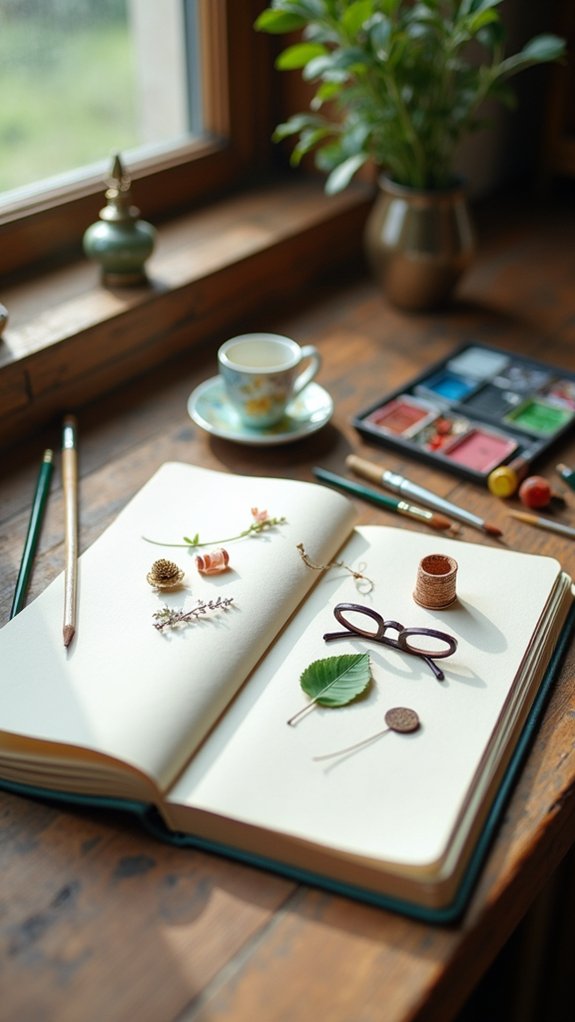
Sometimes, it’s the smallest things that can make the biggest impact, especially in art. Painting a collection of tiny everyday objects—like coins, buttons, or paperclips—can reveal stories hidden in plain sight.
Pick five to eight objects from around your house. Arrange them into a playful collection that looks good together. Think about color, texture, and shape as you plan your masterpiece.
Using different paint techniques, like layering or glazing, can help each object stand out and really pop off the page. Try out various backgrounds for more depth—or a burst of personality.
If you want extra meaning, choose objects that remind you of stories, inside jokes, or wild family adventures. Suddenly, these ordinary things become little stars in your own “object collection” art show.
Invent a New Animal by Combining Three Species
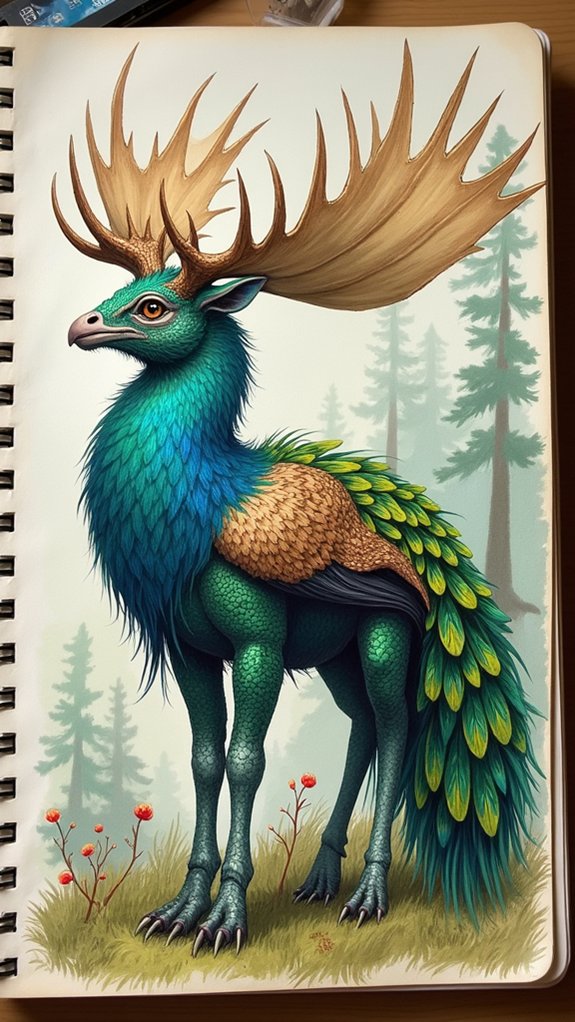
It all starts with picking three totally different animals—imagine the possibilities when you mix an elephant, a parrot, and a turtle!
Think about which features you want to smoosh together: maybe it has a shell with bright feathers stuck on, and a trunk for extra snack-grabbing power.
Don’t forget to picture where this wild combo lives—would it stomp through rainforests, swim along rivers, or perch up high, making everyone wonder what on earth just flew by?
Choosing Three Unique Animals
Imagine being given the chance to play mad scientist with animals—what kinds of wild, wacky creatures could someone dream up by mixing and matching three totally different species?
Picking animals with very different traits is where the fun really starts. Want strength, brains, and a splash of crazy color? Try starting with a lion, a dolphin, and a butterfly! The combinations are endless—think about physical features, unique patterns, and the way each animal acts.
As you get ready for sketching your invented animal, pick three creatures from totally different worlds, and let your imagination run wild! Here are some wacky combos to spark ideas:
- Elephant + Eagle + Octopus
- Kangaroo + Parrot + Turtle
- Cheetah + Owl + Stingray
- Rabbit + Shark + Peacock
- Wolf + Jellyfish + Chameleon
Blending Distinctive Features
When three totally different animals come together in one wild invention, things can get seriously weird—in the best way possible. Imagine a creature with the furry strength of a lion, the sticky toe pads of a frog, and the wild rainbow feathers of a parrot. That’s like inventing the world’s coolest superhero pet! The magic happens when you blend features in new, imaginative ways—like giving your creature parrot wings, lion claws, and a frog’s long, flippy tongue. This isn’t just art. It’s a test of your creative powers, pushing you to think about how anatomy, colors, and textures can mesh together. Artists stretch their skills and invent species that never existed—except in their own wild, creative imaginations.
| Lion (Strength) | Frog (Agility) | Parrot (Color) |
|---|---|---|
| Powerful jaws | Sticky toes | Bright feathers |
| Muscular build | Long tongue | Unique patterns |
| Fierce look | Quick leaps | Vibrant wings |
Imagining Its Habitat
While some artists love dreaming up crazy new creatures, the real magic happens when they picture where that wild combo might actually live.
Imagining its habitat means diving in and asking, “Where could a butterfly-winged, tiger-striped kangaroo hop around and survive?” Artists should think about food, shelter, and how this animal might fit into its world.
Would it need tall grass for camouflage, or bright flowers to attract mates? Every sketch gets more interesting when you build the perfect home for your new creature.
- Mix elements like tree canopies, rivers, or caves into your habitat sketch.
- Imagine weather—does it need sun, rain, or snow?
- Add fun details: What does your animal eat?
- Sketch hiding spots or nesting spaces.
- Think about possible friends—or enemies!
Create an Abstract Pattern With Three Favorite Colors

Color choices can turn a blank page into something unforgettable, especially in the world of abstract patterns. Every sketchbook prompts artist to pick three favorite colors—they could be neon pink, deep blue, or even a wild chartreuse!
Using gel pens, markers, or colored pencils, it’s time to let those colors crash together in a storm of shapes and lines. Abstract patterns aren’t about coloring inside the lines. Try circles, zigzags, or blobs, layering and blending for extra pop.
Don’t forget about negative space; those untouched areas can be just as bold as your brightest doodle. There are no rules here, just the freedom to create a masterpiece that’s totally unique. Let your creativity wander, and watch even simple choices turn into wild designs!
Experiment With Mixed Media on a Single Page

Jump in and smash together all sorts of materials—mixed media is like throwing an art party right on your sketchbook page!
Experimenting with different mediums on a single page can totally shake up your art routine. Imagine layering watercolor splashes, cutting out magazine words, then scribbling over the top with bright gel pens. The textures get wild, and you never really know what awesome effects might pop out.
To get started, pick a focal point—maybe a bold doodle or a glued-on ticket stub—then build around it. Try using anything you can find, from brushes to your fingertips, and see what happens.
Don’t forget to jot down your tool choices and materials in your sketchbook, so you can remember what magical combos you discovered.
- Layer paints, ink, and collage pieces
- Use sponges, brushes, or fingers for new textures
- Mix gel pens, pencils, and markers freely
- Add magazine clippings or ticket stubs for surprise
- Write down your process to track favorite techniques
Capture a Scene From a Recent Nature Walk

Nothing beats the spark of inspiration from a walk in nature. There’s something about stepping into a park, forest, or even the beach that makes drawing feel fresh every day.
Just pick a place you visited recently, and really focus on its special features—maybe twisted tree branches, shimmering water, or a bird hopping on a log. Look at all the colors, the rough and smooth textures, and those weird shapes only nature makes.
Watch how the sun changes everything as it moves, casting crazy shadows across the scene. Every year, the same spot can look totally different, so capturing it in your sketchbook becomes a fun challenge.
Don’t forget to use bold contour lines, playful shading, and color blending to bring it all to life!
Express an Emotion With Abstract Marks
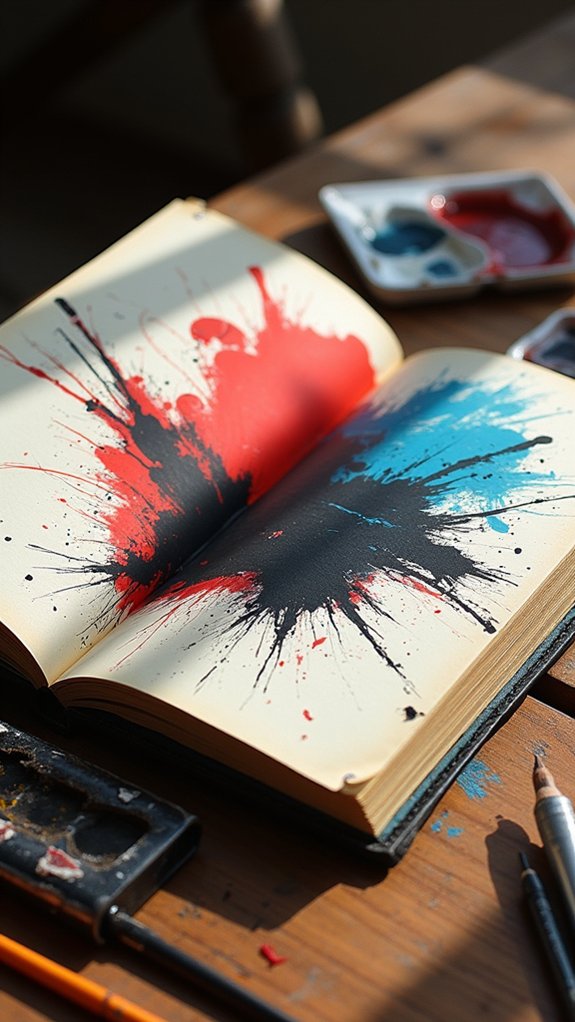
Feelings don’t always like to sit still or fit into neat little boxes, and that’s where abstract art really gets to shine.
In this blog post, artists find that expressing emotions with abstract marks lets them get a little wild—using colors, shapes, and line variations to show joy, sadness, or even pure chaos.
The cool thing? You don’t have to draw faces to shout how you feel from the page! I’d love to see what happens when someone just grabs a brush and lets the feeling take over.
- Splash a single color everywhere when you’re feeling one strong mood.
- Use messy strokes for frustration (who needs neat lines anyway?).
- Layer scribbles for complex emotions.
- Try sharp shapes to show energy or anxiety.
- Reflect on a personal memory’s mood.
Depict a Cultural Tradition Important to You
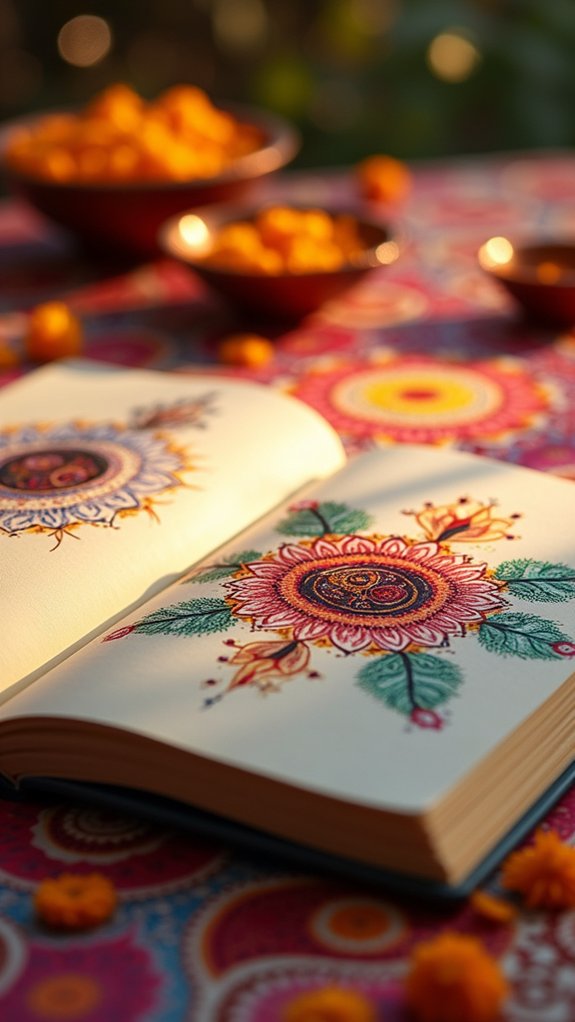
When sketching a cultural tradition that matters to you, think about the little details—like the bright splashes of color in a festival costume, or the special shapes in a favorite holiday food.
These visual elements aren’t just for show; they often have hidden meanings or stories behind them, handed down through generations like family secrets (but with way more glitter).
Visual Elements of Tradition
Ever wondered why certain traditions just feel so powerful, even if you only see them once a year or maybe just in photos?
When sketching cultural traditions, capturing the unique visual elements can really make your drawings pop. Think about how cultural symbolism exploration, traditional attire representation, and the ceremonial object significance all play a role in telling the story of a tradition—not just what people wear, but what those items mean.
- Notice bold patterns on traditional outfits—like a sash that’s more than just a fashion piece
- Find colors that represent the mood, whether they’re neon-bright or earth-toned
- Add carefully chosen ceremonial objects, such as drums or candles, packed with meaning
- Layer different media to make settings rich and lively
- Listen to stories from elders—they’re better than Google for juicy details
Symbolic Meanings in Art
Symbols have a way of sneaking into art, turning simple lines and colors into secret messages about the things people care about most. When artists draw a cultural tradition, it’s like they’re telling a story in another language—one made out of shapes, symbolic colors, and cool cultural motifs that shout “This is who I am!” A dash of red might mean luck, while swirls or animal shapes could stand for bravery or unity. Art can grab those special traditions—festivals, ceremonies, even grandma’s secret bread recipe—and lock them into history, helping with heritage preservation. Take a look at some ideas for how traditions show up in art:
| Symbolic Color | Cultural Motif | Meaning |
|---|---|---|
| Red | Dragon | Good luck |
| Blue | Waves | Peace |
| Gold | Sunburst | Prosperity |
| Green | Vine | Growth |
| Black | Geometric Shapes | Strength |
Illustrate a Dreamlike Fantasy Landscape
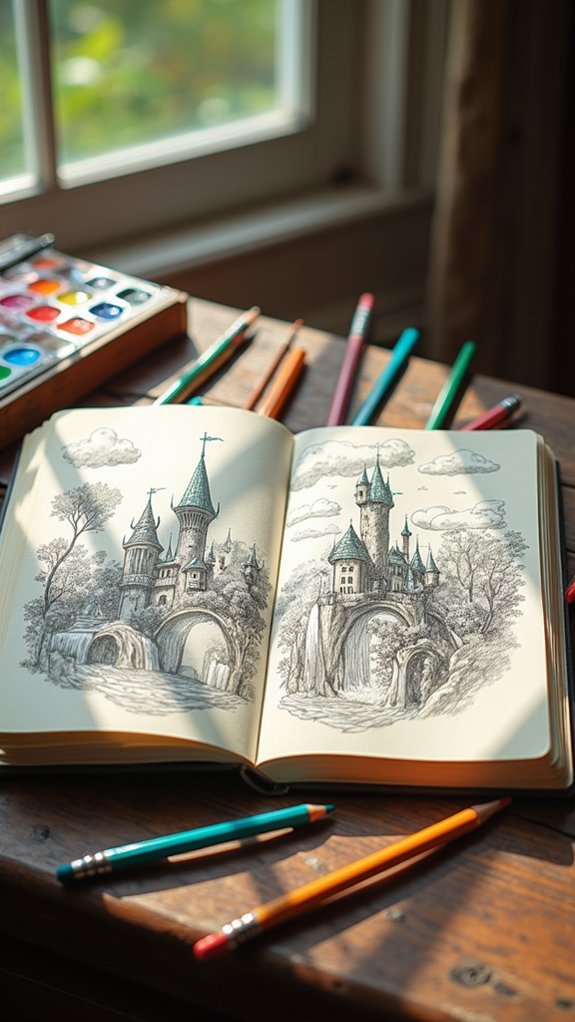
Although the real world has its limits, imaginations don’t have to play by those rules, and that’s exactly what makes illustrating a dreamlike fantasy setting so wild and exciting.
A scenery packed with dreamlike elements—floating islands, twisted trees, and upside-down rivers—breaks every rule you’ve learned in art class. Adding whimsical creatures, like dancing foxes or giant blinking bugs, instantly brings your sketch to life.
Go wild with vibrant colors—try neon skies or glowing green grass—because in a fantasy world, nothing needs to look “real.” Use hazy glows and soft lighting to ramp up the mystery. Mixing inspiration from myths worldwide is like sprinkling in magical story dust.
- Floating islands hovering above colored fog
- Whimsical creatures peeking from behind trees
- Oversized, candy-colored flowers
- Rivers flowing uphill
- Glowing skies with multiple moons
Sketch a Glimpse From Your Daily Routine
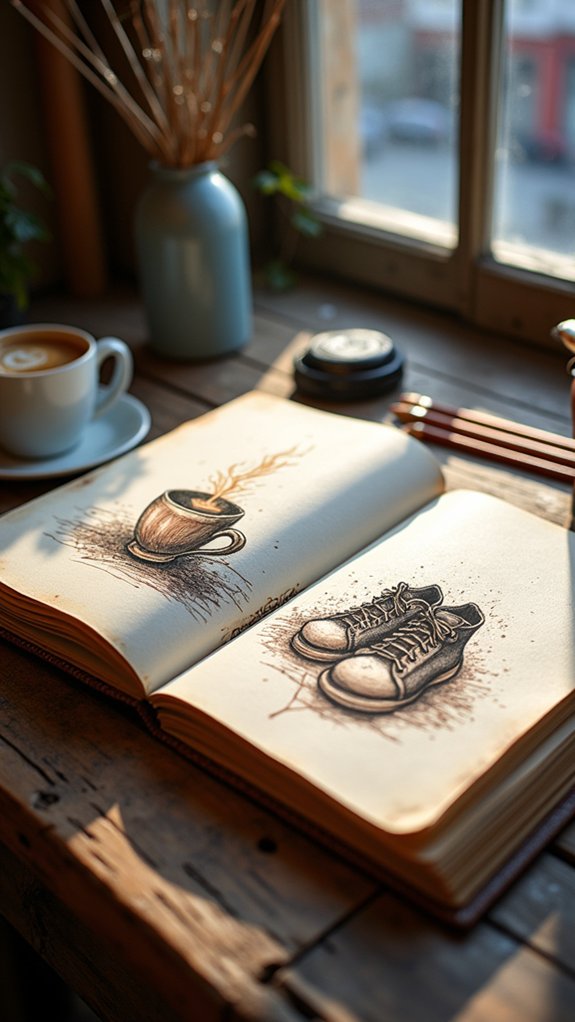
There’s something special about grabbing your sketchbook and drawing the small moments that make up your day, like the messy hair and sleepy smiles at breakfast or your cat trying (and often failing) to sit in your homework pile.
By sketching these ordinary scenes, anyone can add little personal touches—a favorite mug, a wild sock pattern, or even that sneaky pet—making the story their own.
When you celebrate simple daily moments with your art, everyday life starts looking a whole lot more interesting, almost like your routine is hiding secret adventures just waiting to be discovered.
Capturing Everyday Simple Moments
Ever wonder how the ordinary stuff in a day—like brewing coffee, feeding a pet, or just lounging in a cozy blanket—can actually be pretty extraordinary if you really look?
Capturing everyday simple moments in your sketchbook means zeroing in on those everyday details that usually slide by unnoticed. Taking the time to sketch these things can help artists find mindful moments and build creative routines.
Each sketch isn’t just another drawing; it’s almost like a mini diary entry from real life, only cooler and way less embarrassing than actual diary drama.
- Sketch pets doing silly things or napping weirdly
- Draw your breakfast—cereal, toast, or that lumpy oatmeal
- Capture sunlight patterns on your bedroom floor
- Illustrate a favorite cozy corner
- Practice drawing hands as you do routine things
Adding Personal Touches
Spotting those tiny details in ordinary moments is cool, but sketches get even more interesting when they’re loaded with personal touches straight from real life.
Take your morning routine—maybe that chipped blue mug or the zig-zaggy pattern on your bedspread. When you choose objects or moments with personal significance, your sketchbook turns into a time capsule of everyday moments.
It’s not just drawing—it’s mindful sketching, noticing textures, light, maybe even your dog’s nose prints on the window.
Try sketching the same thing at sunrise, or during a rainy afternoon. You’ll see new details every time, and your drawings become as unique as your routine.
Plus, focusing on your own life trains your eyes, and—bonus—it kind of makes you appreciate your daily world more.
Celebrating Ordinary Daily Scenes
While a trip to a famous landmark sounds cool, some of the most interesting scenes are actually hiding right in plain sight—like a half-eaten sandwich on the kitchen table or the mess of shoes by the front door.
By using mindfulness sketching, anyone can turn those tiny, easily-missed moments into art. Sketching daily observations sharpens the eye and gets people to slow down, notice textures, and appreciate all the cool, weird things daily life serves up.
These routine reflections aren’t just about drawings; they’re like pages from a secret diary, telling stories that only the artist lived.
- The view from your breakfast table
- The clutter on your desk after homework
- The plants (or dust bunnies) in your window
- A pet’s favorite napping spot
- Your go-to snack setup after school
Represent Time Using Abstract Forms
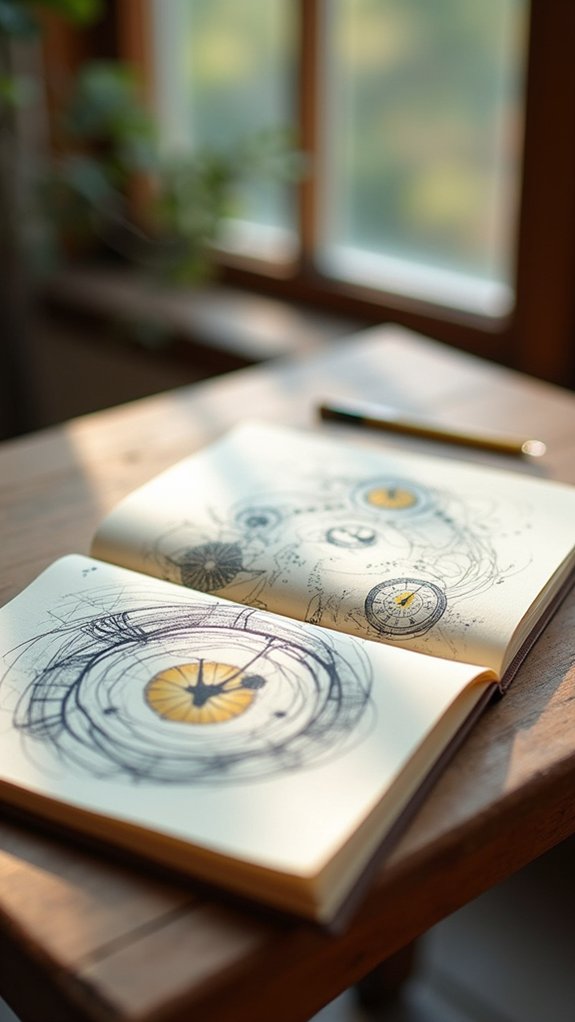
Although time itself can’t be seen or touched, artists have all kinds of wild ways to show it using abstract forms.
Think about spirals spinning like a never-ending clock or waves rolling across your paper—these shapes rock at showing abstract time concepts!
For a dramatic visual time representation, artists splash in the colors of time: blazing reds or oranges for speed and excitement, mellow blues for moments that feel like they last forever.
Layering and making parts transparent can mimic memories stacking up in your mind, hinting at the past, present, and future all at once.
Toss in swirly lines or zigzag patterns to make things feel fast, or super slow.
And hey, don’t forget, mixing in scraps from old calendars always adds a fun twist!
Portrait of a Scientist and Their Invention
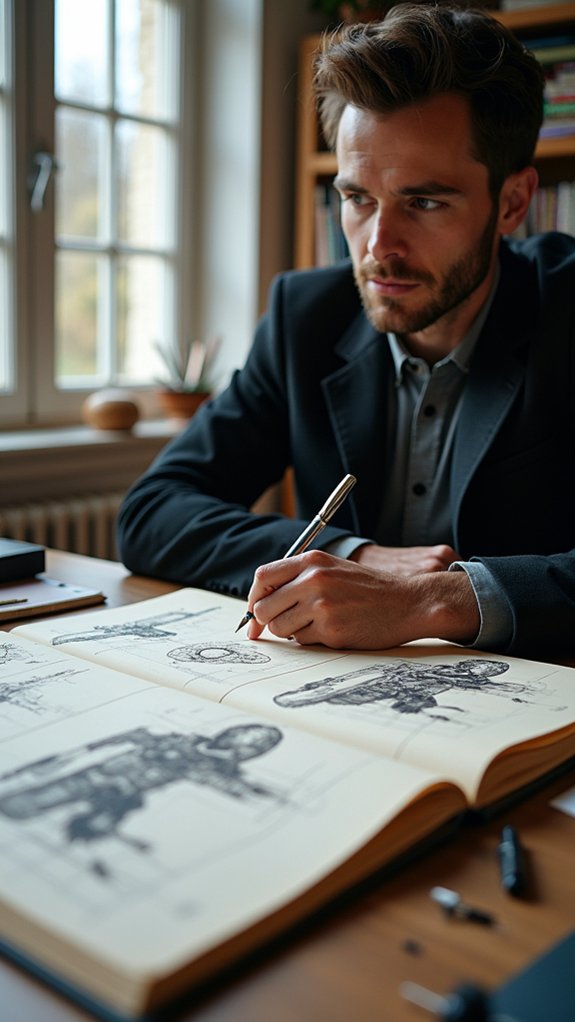
Sketching a famous scientist alongside their invention is a cool way to spotlight genius and creativity, whether it’s Einstein with his wild hair and chalkboard or Marie Curie standing by glowing lab jars.
Choosing the right scientist, picking out the invention that changed everything, and deciding how to show their personality—maybe with a lightning bolt or some spilled coffee—makes your art both fun and powerful.
There’s tons of room for imagination here, so get ready to mix science, history, and a little artistic mischief on your sketchbook page!
Choosing Iconic Scientists
Ever wondered what it would be like to step into the shoes of a world-changing inventor or scientist? Choosing iconic scientists as sketchbook subjects is an awesome way to explore scientific breakthroughs, iconic inventions, and legendary experiments with your own creative twist.
These figures didn’t just dream—they redefined what was possible and shaped the world we understand today. Drawing their portraits offers a chance to capture their personalities, their determination, and that spark of genius. Imagine sketching the twinkle in Einstein’s eye or the intensity on Curie’s face as she worked in her lab.
Here are a few iconic scientists to inspire your next sketchbook page:
- Albert Einstein, master of relativity
- Marie Curie and her radioactivity discoveries
- Thomas Edison, king of invention
- Nikola Tesla, electricity’s wild genius
- Rosalind Franklin, DNA detective
Highlighting Key Inventions
It’s one thing to sketch the brilliant minds behind history’s greatest discoveries, but it gets even more exciting when their inventions step into the spotlight, too.
Imagine drawing Thomas Edison with his bright electric light bulb—suddenly, you’re not just doodling a guy in a suit, you’re showing how he lit up the world.
Or picture Marie Curie, holding a beaker that glows with possibilities thanks to her radioactivity research. Scientific breakthroughs become so much more real when you add in these historical inventions!
What about Nikola Tesla, sparking ideas with his AC electrical system, and Alexander Graham Bell lifting his telephone to his ear?
Even Ada Lovelace deserves an epic portrait, maybe while writing the world’s first computer program—now that’s technological advancement at its finest!
Artistic Interpretation Techniques
Bring a scientist’s portrait to life by mixing art and imagination—no boring mugshots allowed! When drawing a scientist and their invention, it’s all about capturing their spark.
Think about different artistic styles—will it be realistic, cartoonish, or maybe a wild mashup? Use composition techniques to connect the scientist with their invention, like showing them sketching, or surrounded by their prototypes. Emotional expression is key: big smiles, raised eyebrows, or intense gazes can all tell a story.
Don’t forget setting the mood—colors can make things pop or feel chill.
- Show the scientist interacting with their invention for a cool composition
- Pick colors to match their personality and achievements
- Use symbols or background details from their era
- Try layering or glazing for texture
- Emphasize facial expressions for extra emotional punch
Paint a Gathering of People in Your Community

There’s something electric about seeing lots of people come together in one place, whether it’s a bustling farmer’s market, a lively street festival, or even just a small neighborhood picnic.
When an artist paints a gathering like this, it’s a chance to capture real community connections—everyone’s talking, laughing, sharing snacks, or maybe dancing if the music is good!
Using vibrant interactions as inspiration, artists can focus on those small moments: a hug between friends, someone selling homemade bread, or a group playing a game.
Cultural celebrations are perfect for finding bright colors and cool patterns in clothing or decorations, making the scene truly lively.
Every brushstroke can reflect the unique traditions that make each community special, turning everyday moments into meaningful art.
Visualize a Journey of Personal Change
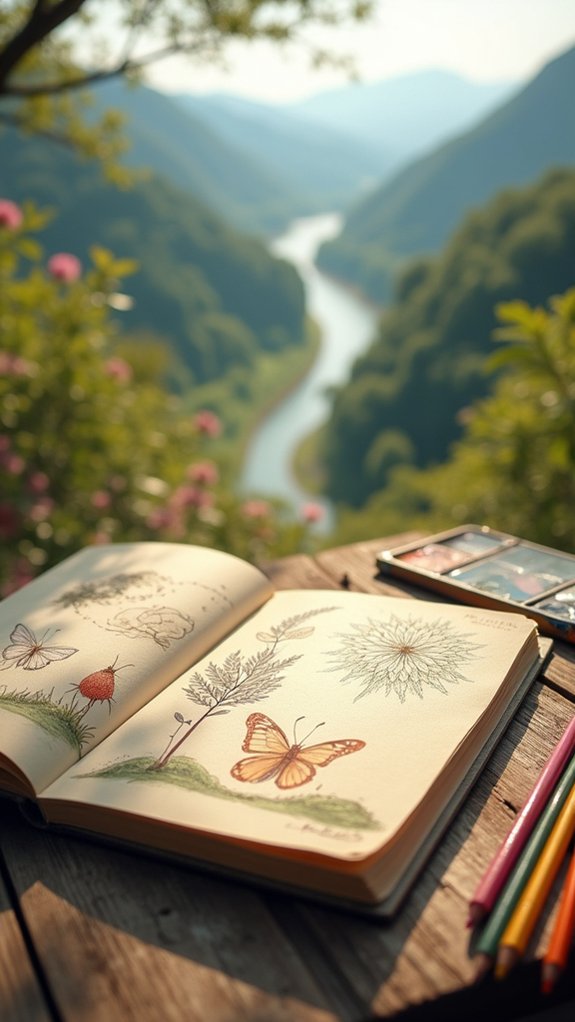
After exploring how communities burst with energy and connection, creativity can also zoom in on the adventure of personal growth.
Visualizing a journey of personal change in your sketchbook can feel a bit like mapping out a story—one where you’re the main character, and metaphorical paths twist and turn through chapters of your life.
Want to show that massive leap you made last year? Try drawing bridges for big moments or crossroads for tough decisions.
Using bold or soft emotional colors helps set the scene for different feelings along the way. Sometimes, sketching isn’t enough—pepper in a bit of journaling or text to highlight memories and lessons learned.
- Sketch winding roads for life’s twists
- Draw bridges for big changes
- Use emotional colors to set moods
- Add crossroads for big decisions
- Include journal notes for context
Fill a Page With Decorated Circles
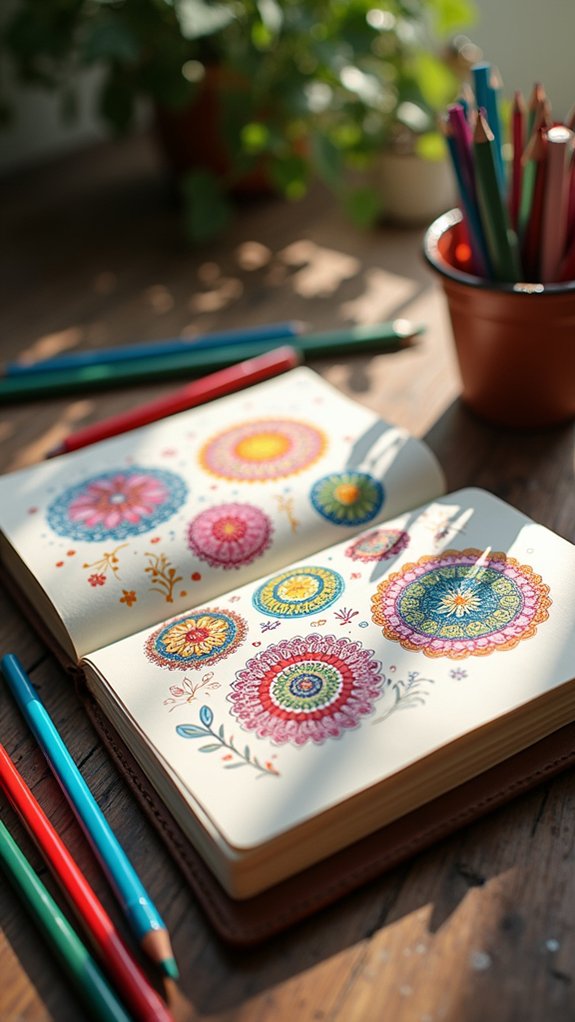
Circles—the humble shape that has no beginning and no end—can actually be a wild playground for the imagination.
Imagine filling an entire page with at least 45 circles, each one acting as a mini canvas. Some circles might shine with bold stripes, others showing off polka dots, zigzags, or tiny checkerboards to create exciting circle patterns.
There’s a twist: overlapping designs! Placing circles so they touch or cross over each other makes the page pop with energy and excitement, adding layers to explore.
With so many options for colorful compositions, from rainbow blends to monochromatic themes, every page turns into a lively party of shapes and shades.
There’s no perfect way to do it, so jump in—you might surprise yourself!
Design Your Dream Skateboard Graphics
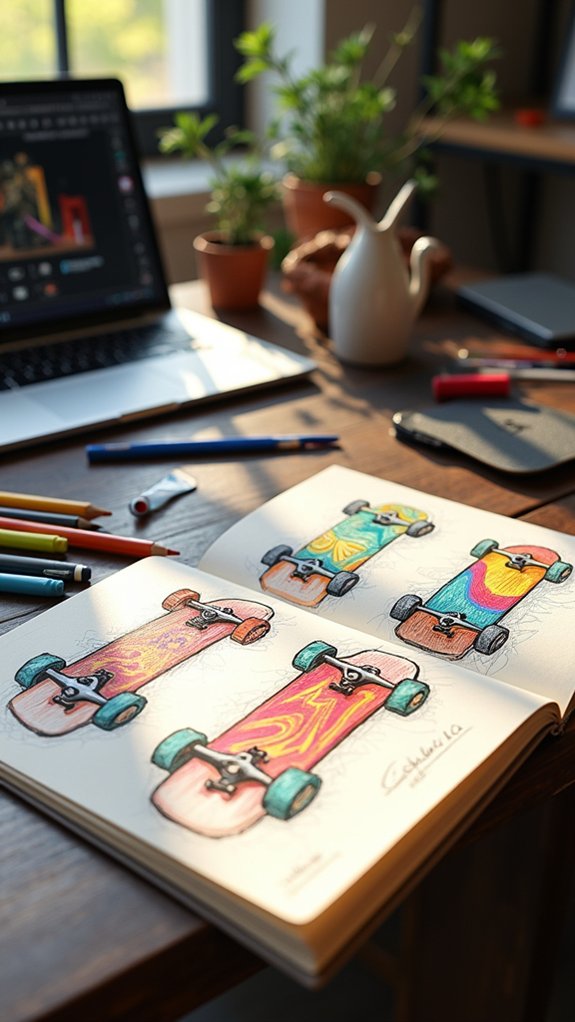
Release bold ideas onto a blank skateboard deck—suddenly, it’s more than just sports gear; it’s your own rolling masterpiece.
Designing dream skateboard graphics is like giving your wildest thoughts wheels! Exploring skateboard color schemes, wild patterns, and out-there illustrations makes every board a slice of your personality.
Graphic design techniques bring these ideas to life—experiment with spray paint, digital art, or even collages. Don’t overlook cultural influences exploration; maybe your favorite band’s logo or a comic book hero jumps onto your design.
And remember, fit the artwork to the deck’s curves and lines so nothing cool gets cut off!
- Mix colors and create stripey gradients
- Try bold typography for your name or motto
- Add doodles inspired by favorite music or TV shows
- Use symbols from your heritage or culture
- Research skateboard art trends, then do your own thing
Fill a Page With Colorful Watercolor Doodle Strokes
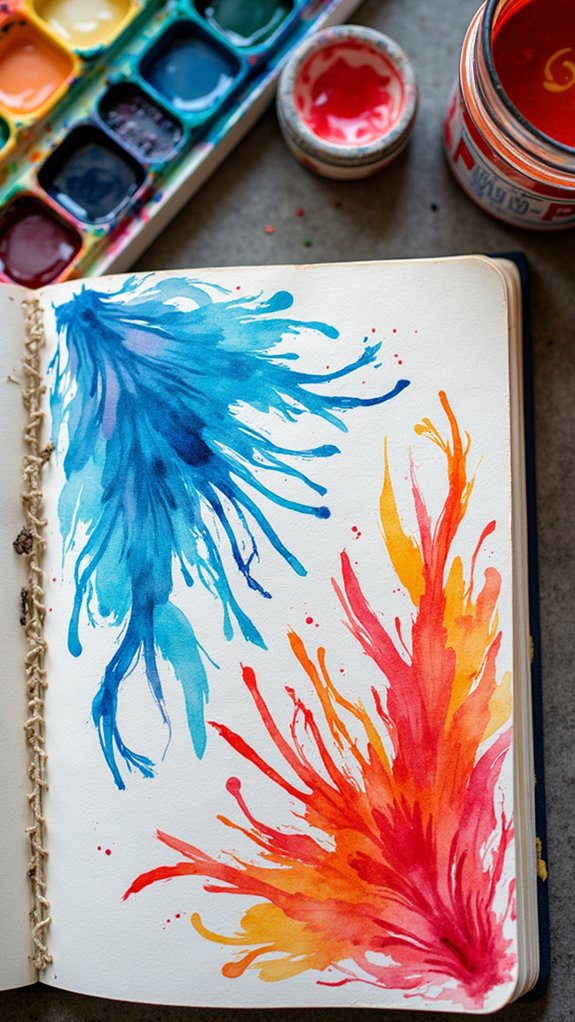
If designing wild skateboard graphics felt like giving ideas wheels, imagine what happens when those ideas splash onto watercolor paper. Filling a page with colorful watercolor doodle strokes turns a blank sheet into a playground for color harmony and texture exploration.
Start by picking a color scheme—think of it as building your team of colors that all get along. Experiment with watercolor techniques like wet-on-wet for splashy blends, or go for crisp lines with wet-on-dry. Add dry brush marks for surprise bursts of texture.
Once the paint is dry, slip in patterns or tiny doodles inside the strokes. Make sure to use thick watercolor paper—floppy pages are a total buzzkill. Take your time, let layers dry, and watch your creativity totally explode!
Draw Something Unexpected Inside a Jar
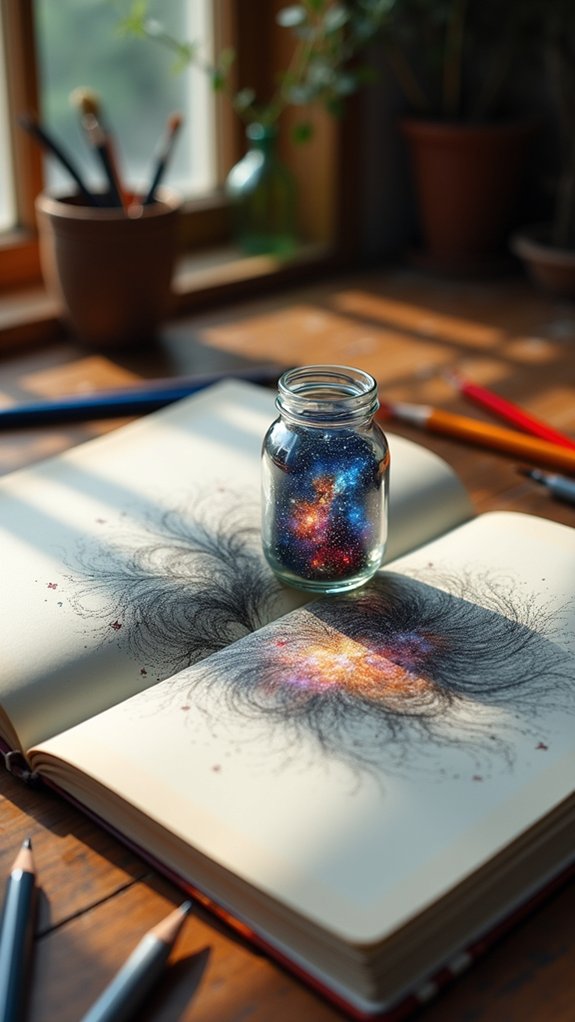
Crank up your imagination and envision this: a plain old jar, but instead of pickles or buttons, it’s packed with something totally wild—maybe a floating castle, a swirling galaxy, or even a bunch of giggling sloths piled on top of each other.
Drawing something unexpected inside a jar is like showing the world your coolest daydreams in a tiny glass container. It’s the perfect gateway to create whimsical creatures, explore emotional reflections, and play with transparent layers.
Try making the glass jar look super real, using highlights and shading for extra wow.
Need some wild ideas? Check out these:
- Tiny dragons napping on marshmallows
- Jar overflowing with lost giggles
- Mystery portal swirling inside
- Memories bottled as colorful music notes
- Sleepy clouds wearing sunglasses
Reimagine Your Bedroom Viewed Through a Keyhole
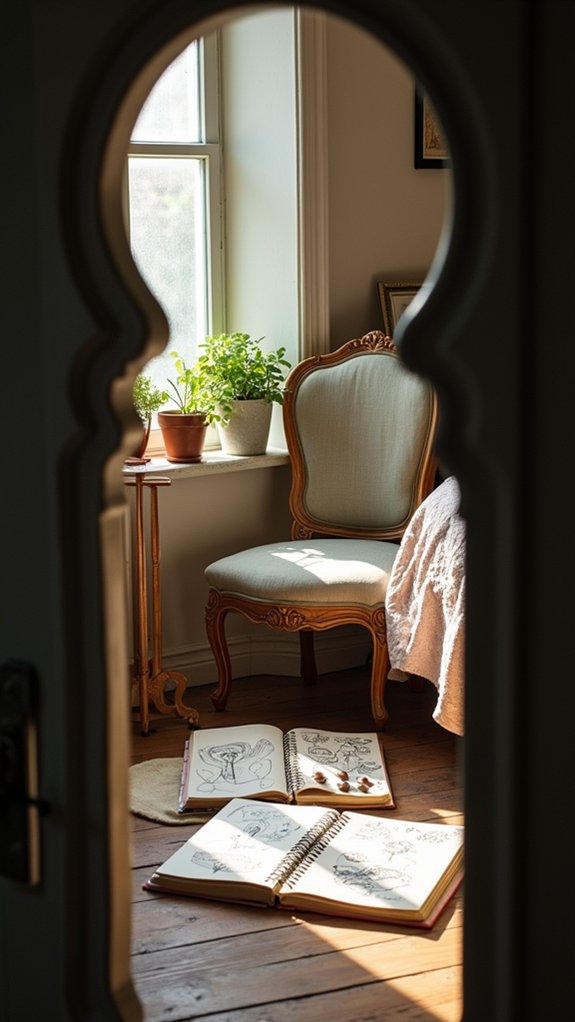
Ever wondered what secrets might hide in a bedroom if you could only peek through a tiny keyhole? That’s exactly what this Keyhole Perspective challenge is all about!
You get to design a bedroom—maybe your own, or a totally wacky one—as if you’re spying through a keyhole. Forget about strict realism. Embrace Creative Design, and add Imaginative Elements that tell a story.
Maybe there’s a stack of comic books, or a secret portal glowing under the bed. Pull in photo references if you want some cool decor ideas or wild color schemes.
With the limited view, you’ll focus on surprising details that usually get overlooked. Think unexpected objects, mysterious lighting, or shadowy corners.
This exercise turns ordinary rooms into secret, magical worlds!
Illustrate the Lyrics of Your Favorite Song
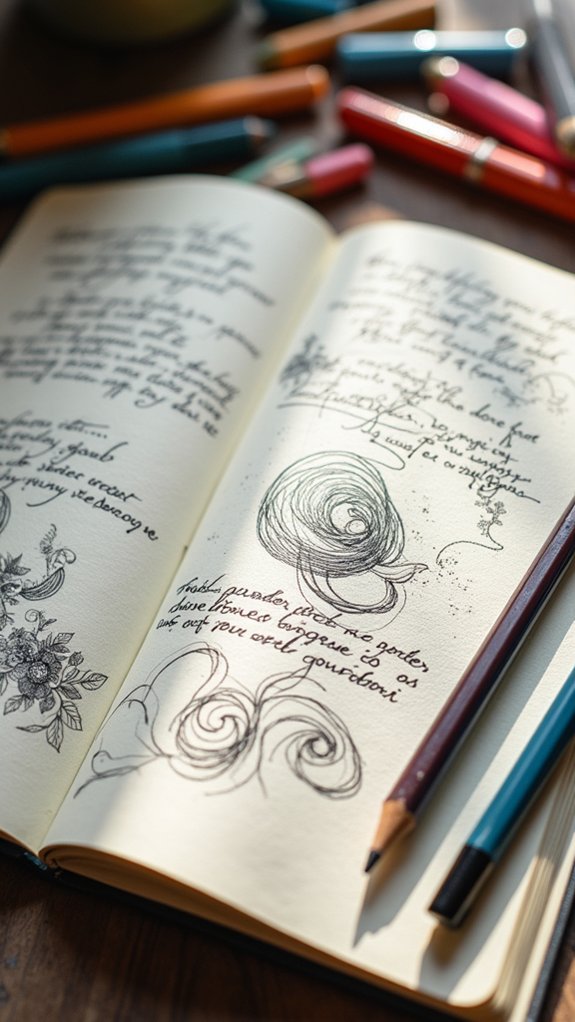
Not every story hides behind a keyhole; sometimes, it blasts through speakers in the form of a favorite song. Turning song lyrics into sketches is like giving your music a new life, but on paper.
By using visual storytelling techniques and picking emotional color palettes, artists can immerse themselves in lyrical themes exploration, making each verse jump right off the page. Sometimes, focusing on a single line or the whole song, you get to mix words and pictures in a totally creative way.
It’s like remixing a song but with pencils instead of playlists.
- Try drawing your favorite lyric using bold typography or hand lettering
- Use colors that match the song’s mood (sad blue, happy yellow—go wild!)
- Create characters for the “story” in the lyrics
- Mix real images and abstract doodles
- Share your work to connect with other music-art fans
Frequently Asked Questions
How Do I Overcome Creative Block in My Sketchbook Practice?
Overcoming creative block often involves practices like visual meditation to clear the mind, engaging in drawing challenges to spark new ideas, and establishing consistent artistic rituals, which together can rejuvenate one’s enthusiasm and maintain regular sketchbook practice.
What Supplies Work Best for On-The-Go Sketching?
When selecting supplies for on-the-go sketching, artists often prioritize portable sketching tools such as fine liners, compact sketchbooks, mechanical pencils, and waterbrushes. Travel friendly mediums and essential sketching supplies guarantee convenience without sacrificing creative potential.
How Can I Develop a Daily Drawing Habit?
The current question focuses on building consistency in practice. Establishing a daily sketching schedule, utilizing a sketching prompts collection for variety, and employing a drawing habit tracker can greatly help an individual commit to a sustainable daily drawing habit.
Are Quick Gesture Sketches Effective for Improving Skills?
Quick gesture sketches are widely recognized for their gesture drawing benefits, providing a foundation for developing dynamic sketching techniques. Practicing these rapid sketches consistently offers notable skill improvement, enhancing both observation accuracy and expressive mark-making in emerging artists.
How Do I Find Inspiration When I Feel Uninspired?
When feeling uninspired, individuals may reignite creativity through artistic exploration, examining environmental influences and emotional triggers. Engaging with new surroundings, reflecting on personal experiences, or experimenting with different techniques can often stimulate fresh perspectives and renewed artistic motivation.
Conclusion
With so many sketchbook ideas buzzing around, there’s really no excuse for a blank page. Every wacky prompt is a chance to surprise yourself—maybe your jar will have a disco-dancing dinosaur! When inspiration runs dry, just pick another idea, and let your pencil take the lead. Remember, mistakes are like plot twists for artists. So keep drawing, keep exploring, and don’t be afraid to fill your sketchbook with whatever pops into your wild, creative mind!

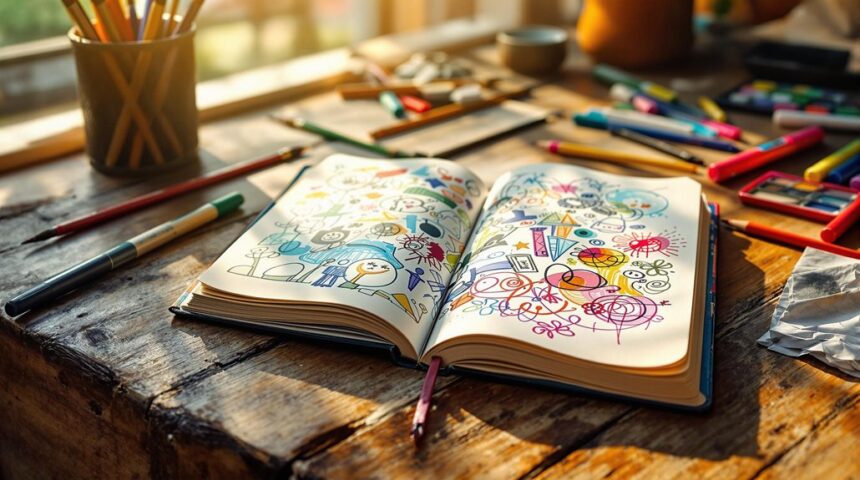
Leave a Reply